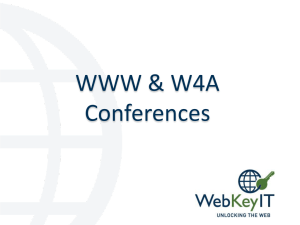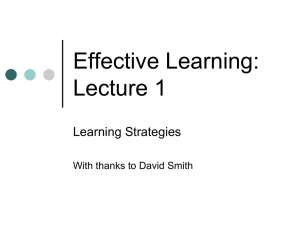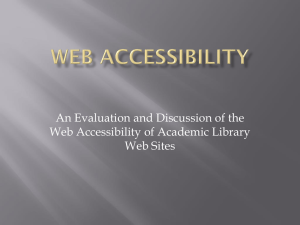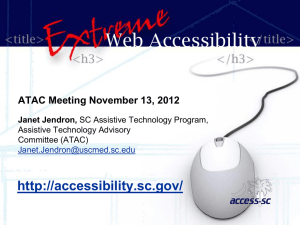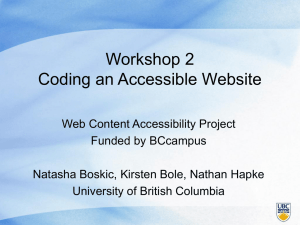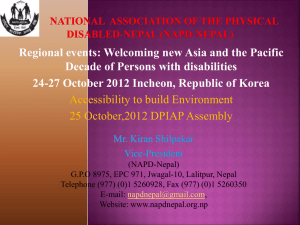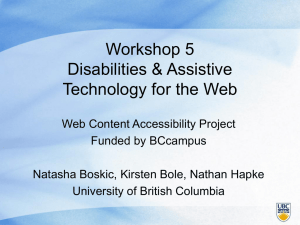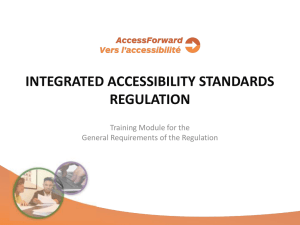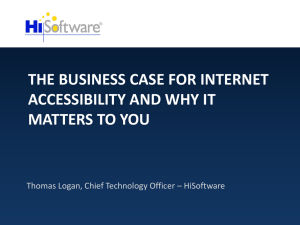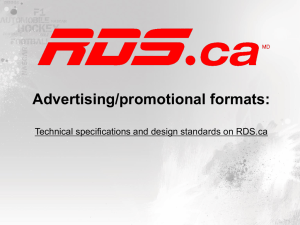information - Training for an Accessible Ontario
advertisement
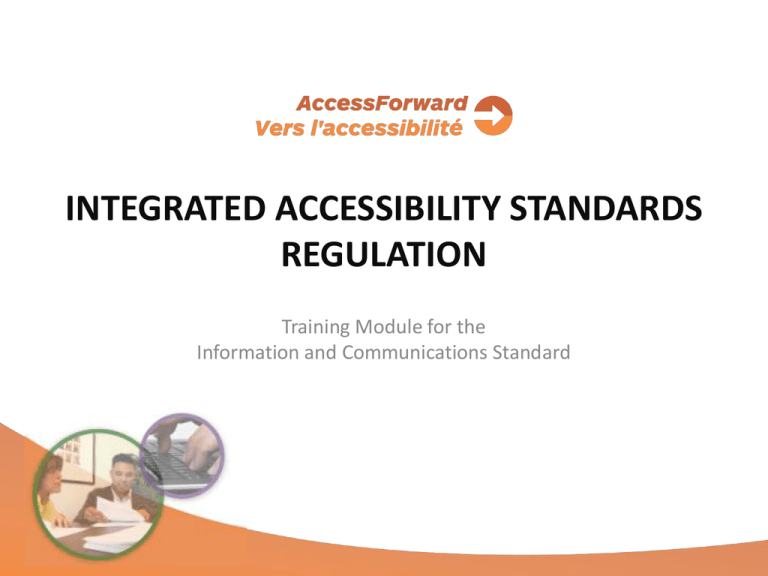
INTEGRATED ACCESSIBILITY STANDARDS REGULATION Training Module for the Information and Communications Standard DISCLAIMER • This training resource is not legal advice and should you require assistance in interpreting the legislation or the regulation, please contact your legal adviser. This resource has been created to assist in understanding the legislation and/or regulation and does not replace the official version of the Integrated Accessibility Standards Regulation, Ontario Regulation 191/11 and the Accessibility for Ontarians with Disabilities Act, 2005 (AODA). If there is any conflict between this resource, the Integrated Accessibility Standards Regulation and the AODA, the regulation and the AODA are the final authorities. • This resource may be used for non-commercial, not-for-profit purposes only in meeting the requirements of the Integrated Accessibility Standards Regulation 191/11. www.AccessForward.ca 2 INFORMATION AND COMMUNICATIONS STANDARD • The Information and Communications Standard is part of the Integrated Accessibility Standards Regulation. • It establishes processes that businesses and organizations in Ontario must follow to create, provide, and receive information and communications in ways that are accessible to people with disabilities. Integrated Accessibility Standards Regulation General Requirements Information and Communications Standard • Other Accessibility Standards Let’s start by watching the introductory video for the Information and Communications Standard. www.AccessForward.ca 3 ABOUT THIS MODULE • In this module you will learn about the requirements of the Information and Communications Standard: – Accessible formats and communication supports – Feedback processes – Emergency procedures, plans, or public safety information – Accessible websites and web content – Educational and training institutions: • Educational and training resources and materials • Training to educators • Libraries of educational and training institutions – Producers of educational or training material – Public libraries • A glossary of key terms for the standard appears at the end of this module. www.AccessForward.ca 4 ACCESSIBLE FORMATS AND COMMUNICATION SUPPORTS • When requested, you must provide information and communications in an accessible manner to people with disabilities. • Alternatives to standard print are often referred to as accessible formats, and ways to help communication between people are referred to as communication supports. • When a request is received, you must consult with the person to determine their accessibility needs. • You have the flexibility to determine the most appropriate accessible format or communication support depending on the accessibility needs of the person and the capability of your organization to deliver. www.AccessForward.ca 5 EXAMPLES OF ACCESSIBLE FORMATS AND COMMUNICATION SUPPORTS • Accessible formats and communication supports must be provided in a timely manner and at a cost that is not more than the regular costs charged to other people. • Examples of alternate formats and communication supports: – Reading written information to a person directly – Large print – Text transcripts of audio or visual information – Handwritten notes instead of spoken word – Information written in plain language – An electronic document formatted to be accessible for use with a screen reader www.AccessForward.ca 6 DEADLINES FOR PROVIDING ACCESSIBLE FORMATS AND COMMUNICATION SUPPORTS Here are the compliance deadlines for providing accessible formats and communication supports: Government of Ontario and Legislative Assembly January 1, 2014 Large designated public sector organizations January 1, 2015 Small designated public sector organizations January 1, 2016 Large (private and not-for-profit) organizations with 50 or more employees January 1, 2016 Small (private and not-for-profit) organizations with 1 to 49 employees January 1, 2017 www.AccessForward.ca 7 EXCEPTIONS TO THE REQUIREMENT • This requirement is about providing accessible information and communications about goods, services, or facilities offered to customers, clients, and others. • The requirement does not apply to the following: – Products and product labels. Example: A store that sells DVDs does not have to make its products or product labels accessible, but the store must still take into account a person’s disability when communicating with them about their products, such as verbally informing a customer with vision loss about their DVD selection. – Information that you do not control directly or indirectly through a contract, unless your organization is involved in education or training as defined in the regulation. – Information or communications that cannot be converted. www.AccessForward.ca 8 WHEN IT’S NOT POSSIBLE... • There might be instances when you are unable to convert the requested information or communication – for example, if: – The technology to convert the information is not readily available, or – The information may be lost in the conversion process and cannot be conveyed in a meaningful way (i.e., visual information in an x-ray or architectural blueprint). • When it’s not possible to convert the requested material, you need to provide the individual making the request with the following: – An explanation as to why the information or communications are unconvertible, and – A summary of the information or communications. www.AccessForward.ca 9 FEEDBACK PROCESSES • Under the Accessibility Standard for Customer Service, organizations had to establish a customer service feedback process for receiving and responding to feedback about how they provide goods or services to people with disabilities. • Your organization may have other types of external or internal feedback processes – e.g., online surveys or forms, email, phone, or print. • Under the Information and Communications Standard, if your organization has feedback processes in place, you must make them accessible. This may include: – Arranging for accessible formats and communication supports on request. – Notifying the public about the availability of accessible formats and communication supports. www.AccessForward.ca 10 COMPLIANCE DEADLINES FOR FEEDBACK PROCESSES Here are the compliance deadlines to make feedback processes accessible: Government of Ontario and Legislative Assembly January 1, 2013 Large designated public sector organizations January 1, 2014 Small designated public sector organizations January 1, 2015 Large organizations with 50 or more employees January 1, 2015 Small organizations with 1 to 49 employees January 1, 2016 www.AccessForward.ca 11 EMERGENCY PROCEDURES, PLANS, OR PUBLIC SAFETY INFORMATION • If your organization provides emergency procedures, plans, or public safety information to the public, you must provide these in an accessible format, on request. • The deadline to comply is January 1, 2012. • Examples of emergency information include, but are not limited to: – Emergency plans and procedures – Maps, warning signs, and evacuation routes – Information you give the public about alarms or other emergency alerts • Real-time emergency information (such as announcements and alarms) is not included in this requirement. www.AccessForward.ca 12 KNOWLEDGE CHECK The Information and Communications Standard applies to which of the following? Choose the best response. A. Information that you do not control directly or indirectly through a contract, unless your organization is involved in education or training B. Products and product labels C. Information and communications about products and services that your organization provides D. Information and communications that cannot be converted www.AccessForward.ca 13 KNOWLEDGE CHECK: ANSWER The Information and Communications Standard applies to which of the following? Choose the best response. A. Information that you do not control directly or indirectly through a contract, unless your organization is involved in education or training B. Products and product labels C. Information and communications about products and services that your organization provides D. Information and communications that cannot be converted www.AccessForward.ca 14 ACCESSIBLE WEBSITES AND WEB CONTENT • An organization’s website is often a primary way it shares information – that’s why it’s important that your website and web content be accessible. • Your organization must conform with the international Web Content Accessibility Guidelines (WCAG) 2.0, as outlined in the standard. • These guidelines were developed by the World Wide Web Consortium (W3C) and explain how to make web content more accessible to people with disabilities. • WCAG 2.0 has different levels of compliance that determine how accessible a site is. www.AccessForward.ca 15 EXAMPLES OF WCAG WEB ACCESSIBILITY FEATURES Examples of web page features required by the WCAG compliance Levels A and AA include the following: Level A feature Level AA feature Alternative text appears when your mouse hovers over an image. It’s important to use appropriate text when describing an image so that screen reader technology can describe the image to a person with vision loss. Properly named headings and labels enable people using screen reader technology to scan through information on a web page efficiently. For example, to quickly identify what stories are on the home page of a newspaper, a screen reader can search just the headings for each story. Properly labelled headings allow the screen reader to tell when one article stops and the next begins. If this is not done, every individual article will be read as one story. Each header should be labelled with the news article’s subject. This allows users to easily find the information they want. www.AccessForward.ca 16 COMPLIANCE DEADLINES FOR WEBSITE ACCESSIBILITY REQUIREMENTS Here are the compliance deadlines for websites and web content: • Government of Ontario and Legislative Assembly: To set an example for other organizations, the Government of Ontario and Legislative Assembly have earlier deadlines than other organizations in meeting the requirements (see the timelines tool for details). • All designated public sector organizations, and all large organizations: – By January 1, 2014, new Internet websites and web content available on these sites must conform with WCAG 2.0 Level A. – By January 1, 2021, all Internet websites, and all web content available on these sites developed after January 1, 2012, must conform with WCAG 2.0 Level AA. The exceptions are live captioning and prerecorded audio descriptions. • There are no website requirements for small organizations (1 to 49 employees). www.AccessForward.ca 17 KNOWLEDGE CHECK By which date must all new Internet websites of designated public sector organizations and large organizations conform with WCAG 2.0 Level A requirements? A. 2014 B. 2016 C. 2021 www.AccessForward.ca 18 KNOWLEDGE CHECK: ANSWER By which date must all new Internet websites of designated public sector organizations and large organizations conform with WCAG 2.0 Level A requirements? A. 2014 B. 2016 C. 2021 www.AccessForward.ca 19 EDUCATIONAL AND TRAINING INSTITUTIONS • Certain sections of the standard apply specifically to educational and training institutions, such as: – Public and private elementary and secondary schools – Colleges and universities – Other educational and training organizations defined in the regulation www.AccessForward.ca 20 WHICH EDUCATIONAL AND TRAINING INSTITUTIONS MUST COMPLY Institutions that must comply include: • Organizations governed by the Education Act or the Private Career Colleges Act, 2005. • Organizations offering all or part of a post-secondary program leading to a degree pursuant to a consent granted under the Post-secondary Education Choice and Excellence Act, 2000. • Designated public sector organizations (colleges and universities) described in paragraph 3 or 4 of Schedule 1 of the IASR. • Public or private organizations that provide courses or programs or both that result in the acquisition by students of a diploma or certificate named by the Minister of Education under the Education Act, subsection 8(1), paragraph 1. • A private school within the meaning of the Education Act. www.AccessForward.ca 21 REQUIREMENTS SPECIFIC TO EDUCATIONAL AND TRAINING INSTITUTIONS • The following sections of the standard apply specifically to educational and training institutions: – Educational and training resources and materials – Training to educators – Libraries of educational and training institutions • These requirements are outlined on the next few slides. www.AccessForward.ca 22 EDUCATIONAL AND TRAINING RESOURCES AND MATERIALS • If you belong to an educational or training institution and a student notifies you of a need due to a disability, you must: – Provide learning resources or material in an accessible format that takes into account their accessibility needs. – Provide student records and program information in an accessible format that takes into account their accessibility needs. • You can provide the student with one of the following: – An accessible or conversion-ready electronic format, where available, or – A comparable resource in an accessible or conversion-ready format, if the resource cannot be obtained or converted to an accessible format. www.AccessForward.ca 23 COMPLIANCE DEADLINES FOR TRAINING RESOURCES AND MATERIALS Here are the compliance deadlines for educational and training institutions to meet the requirements of this section: Large designated public sector organizations January 1, 2013 Large organizations with 50 or more employees January 1, 2013 Small designated public sector organizations January 1, 2015 Small organizations with 1 to 49 employees January 1, 2015 www.AccessForward.ca 24 TRAINING TO EDUCATORS • Educators need to know how to make their teaching accessible. • This means that educational and training institutions must: – Provide educators with accessibility awareness training related to accessible course delivery and instruction. – Keep records of training provided, including the dates it was provided and the number of individuals trained. www.AccessForward.ca 25 COMPLIANCE DEADLINES FOR EDUCATOR TRAINING Here are the compliance deadlines for organizations to provide their educators with accessibility awareness training: Large designated public sector organizations January 1, 2013 Large organizations with 50 or more employees January 1, 2013 Small designated public sector organizations January 1, 2015 Small organizations with 1 to 49 employees January 1, 2015 www.AccessForward.ca 26 LIBRARIES OF EDUCATIONAL AND TRAINING INSTITUTIONS • Where available, libraries of educational or training institutions must provide an accessible or conversion-ready format of print, digital, or multimedia resources or materials, on request. • The following are exempt from the requirements: – Special collections – Archival materials – Rare books – Donations www.AccessForward.ca 27 COMPLIANCE DEADLINES FOR LIBRARY MATERIALS Here are the deadlines for libraries of educational and training institutions to meet the requirements of this section: • By January 1, 2015, they must provide accessible formats for print-based resources or materials, on request. • By January 1, 2020, they must provide accessible formats for digital or multimedia resources or materials, on request. www.AccessForward.ca 28 PRODUCERS OF EDUCATIONAL OR TRAINING MATERIAL • Producers of educational or training textbooks and print-based learning resources who supply educational and training institutions must provide accessible or conversion-ready versions, when requested. • Examples of producers include, but are not limited to: – Publishing companies – Universities – School boards www.AccessForward.ca 29 COMPLIANCE DEADLINES FOR THIS SECTION Here are the deadlines for producers of educational or training material to meet the requirements of this section: • By January 1, 2015, they must provide accessible or conversion-ready versions of textbooks, on request. • By January 1, 2020, they must provide accessible or conversion-ready versions of printed educational or training supplementary learning resources, on request. www.AccessForward.ca 30 PUBLIC LIBRARIES • Public libraries must: – Provide or arrange to provide accessible materials where they exist, when requested. – Make information publicly available to inform people that materials can be provided in an accessible format, on request. Keep in mind that this information needs to be accessible as well. • The deadline for public library boards to comply is January 1, 2013. www.AccessForward.ca 31 KNOWLEDGE CHECK Which of the following statements is false? Choose the best response. A. Special collections and rare books must be provided in an accessible format at libraries of educational and training institutions. B. Student records must be provided in accessible formats, on request. C. Educational and training institutions must provide educators with accessibility awareness training. D. Colleges and universities must provide learning materials in accessible formats, on request. www.AccessForward.ca 32 KNOWLEDGE CHECK: ANSWER Which of the following statements is false? Choose the best response. A. Special collections and rare books must be provided in an accessible format at libraries of educational and training institutions. B. Student records must be provided in accessible formats, on request. C. Educational and training institutions must provide educators with accessibility awareness training. D. Colleges and universities must provide learning materials in accessible formats, on request. www.AccessForward.ca 33 SUMMARY • You have now completed the Information and Communications Standard module. • Module topics: Accessible formats and communication supports Feedback processes Emergency procedures, plans, or public safety information Accessible websites and web content Educational and training institutions: • Educational and training resources and materials • Training to educators • Libraries of educational and training institutions Producers of educational or training material Public libraries www.AccessForward.ca 34 GLOSSARY • accessible formats: Formats that are an alternative to standard print and are accessible to people with disabilities. May include large print, recorded audio and electronic formats, and Braille. • communications: As used in the Information and Communications Standard, refers to the interaction between two or more people or entities when information is provided, sent or received. • communication supports: Supports that individuals with disabilities may need to access information. Some examples include plain language, sign language interpreter, reading the information out loud to a person with vision loss, adding captioning to videos or using written notes to communicate with someone who is hard of hearing. • conversion-ready formats: Any electronic or digital format that facilitates conversion into an accessible format, such as Braille, large print, audio, etc. www.AccessForward.ca 35 GLOSSARY • educators: Employees who are involved in program or course design, delivery and instruction, including staff of schools boards. • Government of Ontario: Refers to the executive of the government and operational branches, including all the ministries of the Government of Ontario and the Office of the Premier. • information: As used in the Information and Communications Standard, refers to knowledge, data and facts that convey meaning and that exist in any format, such as text, audio, digital or images. • Internet website: An organization’s external website that is available to the public and contains a collection of related web pages, images, videos or other digital assets. It is accessible through an Internet address known as a Uniform Resource Identifier. www.AccessForward.ca 36 GLOSSARY • large designated public sector organization: A designated public sector organization with 50 or more employees (such as municipalities, hospitals, universities, colleges of applied arts and technology, district school boards and organizations that provide public transportation). • large organization: Refers to a private or not-for-profit organization that provides goods, services or facilities to the public or to other organizations and has 50 or more employees in Ontario. It does not include the Government of Ontario, Legislative Assembly, or designated public sector organizations. • Legislative Assembly: Refers to the Offices of the Legislative Assembly of Ontario including all the offices of the Members of Provincial Parliament (MPPs), their constituency offices in their ridings and the offices of those appointed on the address of the Assembly, such as the Speaker of the Legislative Assembly of Ontario. www.AccessForward.ca 37 GLOSSARY • library board: Refers to a board as defined in the Public Libraries Act. It also refers to a board established under the Northern Services Board Act or a county library established under the County of Lambton Act, 1994, the County of Elgin Act, 1985 or the County of Lennox and Addington Act, 1978. • live (on-line) captioning: Text alternative provided in real-time for information captured for a live event. Provides both speech and nonspeech audio information needed to understand the content including sound effects, music, laughter, speaker identification and location. • pre-recorded audio descriptions: Narration added to the soundtrack of visual media (including television and film, dance, opera, and visual art). Describes important visual details that cannot be understood from the main soundtrack alone. Consists of a narrator describing the on-screen action during the natural pauses in the audio. Often used by people with vision loss. www.AccessForward.ca 38 GLOSSARY • screen reader software: Software programs that allow users to read the text displayed on the computer screen with a speech synthesizer. Often used by people with vision loss or have a learning disability. • small designated public sector organization: A designated public sector organization with one to 49 employees (such as the Ontario Office of the Fairness Commissioner and some municipalities). • small organization: Refers to a private or not-for-profit organization that provides goods, services or facilities to the public or to other organizations and has one to 49 employees in Ontario. It does not include the Government of Ontario, Legislative Assembly, or a designated public sector organizations. • timelines tool: A quick reference chart providing the deadlines for meeting the requirements of the regulation based on organizational class and size. Can be viewed in the Training Resources section of the AccessForward website. www.AccessForward.ca 39 GLOSSARY • Web Content Accessibility Guidelines (WCAG) 2.0: An international standard for making websites and web content accessible to people with a wide range of disabilities. Was developed by a team of experts from around the world. The first version, WCAG 1.0, was released in 1999. WCAG 2.0 was released in 2008. • Web Content Accessibility Guidelines (WCAG) 2.0, Level A and Level AA: Refers to different conformance levels in WCAG 2.0. A series of technical checkpoints that make websites and their content increasingly accessible to a broader range of users with disabilities. To meet conformance Level A all Level A success criteria need to be met; to meet conformance Level AA all Level A and Level AA success criteria must be met. • web content: Any information that may be found on a web page or web application, including text, images, forms and sounds. For a complete glossary of terms, please visit www.AccessForward.ca and download the PDF version from the Training Resources section. www.AccessForward.ca 40

